 Do you use stories to engage your audience?
Do you use stories to engage your audience?
Want to see how powerful stories can be?
To discover how to create stories for business that move people to act, I interview Park Howell.
More About This Show
The Social Media Marketing podcast is an on-demand talk radio show from Social Media Examiner. It's designed to help busy marketers and business owners discover what works with social media marketing.
In this episode I interview Park Howell, a brand story strategist who helps businesses grow through the power of stories. He also hosts the Business of Story podcast and performs workshops on stories for business.
Park will explore the mechanics of storytelling, a craft every marketer should master.
You'll discover why this is important to social marketers.
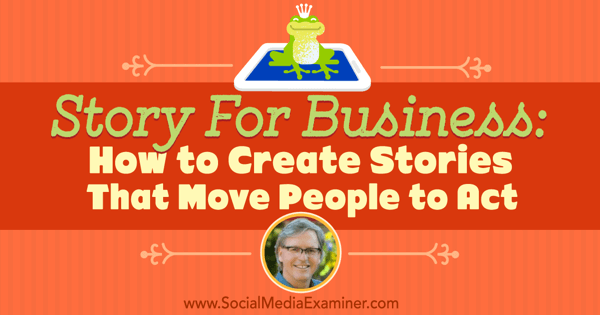
Share your feedback, read the show notes, and get the links mentioned in this episode below.
Listen Now
Where to subscribe: Apple Podcasts | Spotify | YouTube Music | YouTube | Amazon Music | RSS
Here are some of the things you'll discover in this show:
Story for Business
Park's story
Park, who has been in the advertising and marketing business for 30 years, shares that what always frustrated him was not knowing whether a TV spot or radio commercial was going to work.
Story started to bubble up in the advertising world around the same time Park's middle son, Parker, went to Chapman University film school (from 2006 to 2010). He asked Parker to send him his textbooks when he was finished with them because he wanted to see what they were teaching his son to prepare him for Hollywood, the most competitive storytelling place in the universe.
One of the screenwriting books was Save the Cat! by Blake Snyder. Blake, who Park says sold more family-oriented screenplays in the 1980s than anybody else, had a prescription for the 15 beats to a story.
Get World-Class Marketing Training — All Year Long!
Are you facing doubt, uncertainty, or overwhelm? The Social Media Marketing Society can help.
Each month, you’ll receive training from trusted marketing experts, covering everything from AI to organic social marketing. When you join, you’ll also get immediate access to:
- A library of 100+ marketing trainings
- A community of like-minded marketers
- Monthly online community meetups
- Relevant news and trends updates
According to Blake, a screenplay needs to be the same number of pages as the weight of a jockey (110), and Blake could tell you on each page (within a page or two) what needed to happen. Although it sounds formulaic, it worked very well for Blake and many other writers, Park adds, and the approach fascinated him.
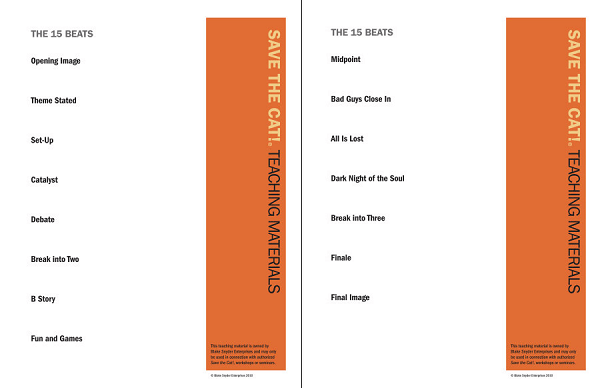
When Park was introduced to the work of Joseph Campbell, America's foremost mythologist, he noted how Blake had adapted Campbell's The Hero's Journey, or what Joseph called the monomyth, a 17-step process for story structure.
During the time Park was reading through The Hero's Journey, he was looking at a brand strategy plan and realized he was already following this story structure with his plan. Park wondered what would happen if he was intentional about it.
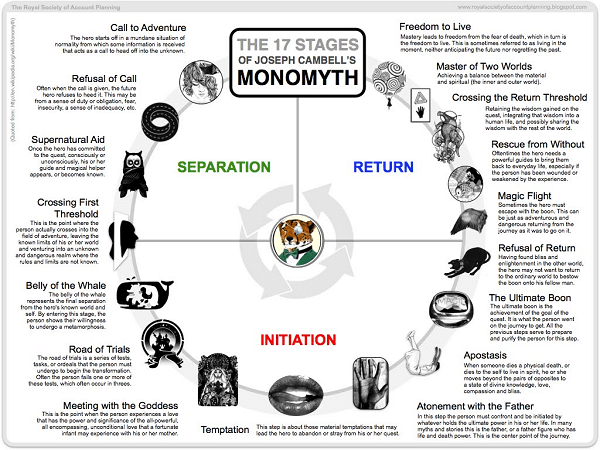
Park boiled down the steps of the Hero's Journey to 10 steps for business, and used it to guide the creation of content to tell a story that would make a difference. To Park's amazement, it worked, so he fine-tuned it into what he calls the Story Cycle, a process that can be used for everything from high-level brand strategy to the creation of a 30-second TV spot.
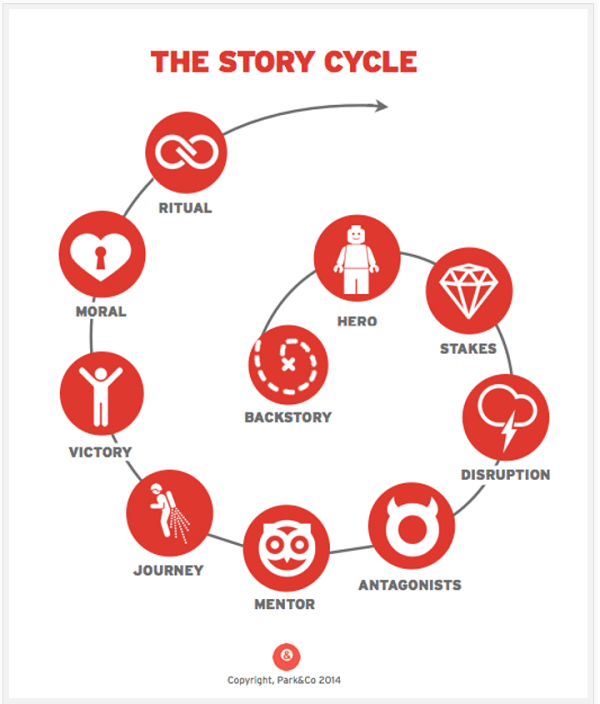
In the social media world, you just have a small blip of time to communicate a story. Park explains that you can get that story across if you follow the three fundamental principles of the three-act play: start with a setup, introduce conflict, and resolve it.
He shares that if you can do it in a 6-second Vine video, you will have connected with the deep reaches of your audience's minds.
Listen to the show to learn about Park's background in music, as well as his comparisons between music and story.
Why marketers should care about stories
Park believes that stories are people's superpowers, and says the brain is hardwired to constantly search for them. Humans can go weeks without eating and days without drinking, but only roughly 35 seconds without their brains scanning the environment to create meaning out of what they see.
Park explains how while one son was studying film and Park was studying what Hollywood knows about story structure, his youngest son was dealing with physical challenges that stemmed from encephalitis and brain surgery. During that time, Park was reading everything he could about how the mind functions.
That's when, for Park, what Hollywood knows about story structure intersected with the neuroscience of how the brain takes in, absorbs, and processes story.

Use story respectfully and you can have tremendous impact where you live, where you teach, and when you sell, he says. As a caution, Park always tells people to use story for good, not evil, because you can move people in all different directions with the right story.
When you hear a story, you automatically filter it through your experience as the hippocampus pulls up memories. While the brain tells itself a story, it tries to run non-stop scenarios to figure out the best response, and then acts upon that scenario. And it does that in milliseconds.
Nature gave people story to draw their rapt attention, Park adds. There's a book called Rapt: Attention and the Focused Life by Winifred Gallagher, and story is the theme throughout the book. Nature wants people to stay alive and create more of themselves. Running scenarios (stories) in real time and in dreams helps people figure out what to do next.
Listen to the show to discover what the authors and screenwriters Park has interviewed on his podcast have to say about story.
How to build a story
Park says he came up with his story structure by studying a lot of really smart people and connecting the dots that work for him, his life, and his business. One of those people is Randy Olson, a surfer and Harvard PhD oceanographer who lives in Malibu, California.
Randy gave up tenure at the University of New Hampshire, went to University of Southern California Film School, made a few documentaries, and recently published his third book, called Houston, We Have a Narrative. Randy's mission in life, as a PhD scientist turned communicator, is to help the science world understand how to do a better job of talking in narrative form versus throwing out a bunch of stats and facts that don't resonate with others.

Park explains how he came across a construct called, “And, But, and Therefore,” which he got from South Park creators Trey Parker and Matt Stone, who have a hand in every script. When they find a script falling flat, they do the Rule of Replacement. The take out the “ands” and replace them with “buts” and “therefores.”
Park gives an example of what happens when you incorporate And, But, and Therefore into a story.
- Act 1, the setup is, “I got up to walk the dog and we ran out into the street and headed down to grab a cup off coffee.”
- Act 2 is, “But a car came careening around the corner and was heading directly for my poor pooch.”
- Act 3 is, “Therefore, I did the only thing I could do. I reached down, grabbed him by the scruff of the neck, jumped out of the way just in time for the driver to get off of his text and wheel his car back into the center of the road and off he went.”
When you tell a story, you allow listeners to live vicariously though you, and they will learn a lesson from it. In this case the lesson is, “Next time I walk my dog, I'm going to pay more attention, especially to people who may be texting behind the wheel.” Listeners then think about the best way to get out of that situation should they find themselves in it.

If you're trying to write a campaign and it's not coming together, start with an And, But, and Therefore, placing your customer at the center of the story. For example, Park says, “Sally would love to have longer, lusher hair. And she has tried all of the regular products. But doesn't like the chemicals in them. Therefore, our all-organic soy-based shampoo is the answer for Sally.”
It's the most basic construct that will work for everything from a presentation to a proposal, from an ad to a tweet. Simply ask yourself what you are trying to say, then Use And, But, and Therefore to build the foundation for your story. Once you have that, you can fill your story out with elaborate nuances.
Park also goes deeper into story structure, and shares some historic comparisons. Aristotle would say you have a beginning, middle, and end. Hegel the philosopher would say you have the thesis, antithesis, and synthesis, which is the basic structure of argument. Mozart wrote sonatas and invented the sonata-allegro form, which is all about exposition, development, resolution. Regardless of the name, he says, they're all the same thing; a three-act play.
Park further discusses the structure of story.
You start with the setup or backstory in Act 1. This is where you give your story in context. Who is in the story, what is happening in the story, and where is it happening? In Act 2, or the middle, you introduce the conflict, which comes with the “but.” Remember, without conflict, you have no story. You end your story in Act 3 with the resolution. How does this all come together? What is the learning experience? What is the truth? That's why every story has a moral that's either explicit or implicit within the story.
Begin with the end in mind, Park shares, and what you're trying to impart in the story will shape what goes into the beginning. For example, Park says he tries to figure out who his audience is and what wisdom he's trying to impart to them. That leads him to what kind of story he's creating, where the story takes place, and how he's going to tell that story to emotionally connect with his audience.

Discover Proven Marketing Strategies and Tips
Want to go even deeper with your marketing? Check out the Social Media Marketing Podcast! Publishing weekly since 2012, the Social Media Marketing Podcast helps you navigate the constantly changing marketing jungle, with expert interviews from marketing pros.
But don’t let the name fool you. This show is about a lot more than just social media marketing. With over 600 episodes and millions of downloads each year, this show has been a trusted source for marketers for well over a decade.
In response to my mentioning how the TV show Seinfeld has stories within stories, Park says it's complicated, but try to do it if you can pull it off. For example, you can successfully include multiple stories on stage or within a lengthy PowerPoint presentation. To effectively weave in a couple of subplots or substories, simply go back to And, But, and Therefore for every one of them. Park reminds listeners to set the foundation, build upon it, and don't stray from it.
Park explains the importance of using story when you share data with your audience. When you lead with data in a story, you automatically set yourself up as an expert, and that's a trigger for the crowd. People fold their arms, even subconsciously, and they want you to prove it.
If, on the other hand, you lead with an event and a story that sets up the data, then it's a Trojan horse. For more on this, Park says to take a look at Jonathan Gottschall's book, The Storytelling Animal: How Stories Make Us Human. John also wrote a great article in Fast Company about the Trojan Horse of Story.

Data does one of three things, Park says. Data either reports an event that has happened, monitors an event that is currently happening, or attempts to predict an event in the future. For instance, a weatherman can report nice weather yesterday, rain today, and a cold snap expected for tomorrow.
Do you really care about the data or do you care about the event? You care about the event, because that dictates what you wear, how you're going to travel, and what you have to look out for. Data can't kills us, but events can. Lead with the event and back up your hypothesis of how the event is going to play out with the data. You'll prove your point and make your message much more interesting.
Listen to the show to discover how I'm working stories into my Social Media Marketing World keynote.
Telling stories on social media
Use visuals to invite your audience to participate in your story, Park suggests, and you'll get much more engagement on social media. Start with a visual that tells or tees up the story you'll play off of in the headline. Whether it's a post or a tweet, be sure to bring it full circle with a call to action.
Park has been having fun creating visuals for Business of Story. Whenever he travels, he looks for the oddest scenes to photograph and shares a recent experience. In an airport, he was watching his son try to catch a bird by putting a French fry in a trap made of a box, a stick, and string. To trick the birds, his son pretended to look away from the trap.
Park took a picture of this scene with his iPhone. When he posted, Park added the headline, “How effective is your content marketing?” and put the Business of Story logo on it. The visual was a complete story that involves the viewer.
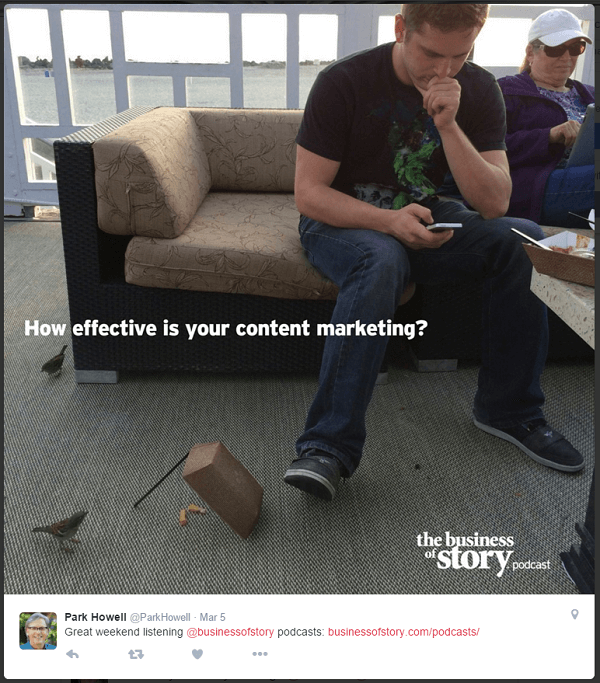
We discuss Zach King's Vine videos, which are great examples of short, complete, visual stories. You don't have to overthink short videos, Park explains. You have two seconds to set it up, two seconds for conflict, and then two seconds to have fun with the payoff. It's a mini-feature documentary that is six seconds long.
Listen to the show to learn more about Zach King and his videos.
Discovery of the Week
Boomerang for Gmail is a browser plugin for Safari, Chrome, and Firefox that works with regular Gmail and Google apps. Boomerang works on the web and on your iOS mobile device, and the developers are working on an Android app version. You can watch the demo here.
Install Boomerang and you can write an email and schedule it to send later. You can also set Boomerang up to let you know if someone hasn't responded to your email by a certain date, then give you a reminder to send it again.

Another helpful use is the snooze functionality. If you know there's a message you want to deal with later in the day, mark it and it will come back at the time you specify.
Boomerang offers a free basic version (10 messages a month), with upgrade and add-on features starting at $4.99 per month.
Listen to the show to learn more and let us know how Boomerang for Gmail works for you.
Other Show Mentions
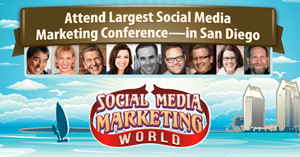 Today’s show is sponsored by Social Media Marketing World 2016.
Today’s show is sponsored by Social Media Marketing World 2016.
Social Media Marketing World 2016 starts in just a couple of days. It’s the world’s largest social media marketing conference. By attending, you’ll make connections with 100+ of the world’s top social media pros (plus 3,000 of your peers) and you’ll discover amazing ideas that’ll transform your social media marketing. Speakers include Guy Kawasaki, Mari Smith, Michael Hyatt, Jay Baer, and Michael Stelzner.
.
See what attendees experienced at our 2015 conference.
The event takes place in San Diego, California on April 17, 18, and 19, 2016.
Hundreds of people have already purchased their tickets and have committed to coming to this conference. If you've heard about Social Media Marketing World, and always wanted to go and connect with the leading thought leaders and soak in a lot of knowledge, visit SMMW16.com.
For a couple weeks after the conference, you can still purchase a virtual ticket to Social Media Marketing World. A virtual ticket gives you access to all of the 100+ sessions, keynotes, panels, and workshops, so you can study the content and benefit from all of the amazing speakers at Social Media Marketing World. It's the best way to experience the conference without the cost of travel.
Click here to check out the speakers and the agenda and grab your live or virtual ticket.
Listen to the show!
Key takeaways mentioned in this episode:
-
- Learn more about Park on his website and follow @ParkHowell on Twitter.
- Listen to the Business of Story podcast.
- Read Save the Cat!, and learn more about Blake Snyder, his Beat Sheet, and how it applies to screenplays.
- Explore Joseph Campbell, read The Hero's Journey, and check out his monomyth process for story structure.
- Read about Park's story cycle.
- Learn more about the hippocampus and read Rapt: Attention and the Focused Life by Winifred Gallagher.
- Check out Randy Olson and read Houston, We Have a Narrative.
- Explore And, But, and Therefore.
- Learn more about South Park and watch creators Trey Parker and Matt Stone talk about their Rule of Replacement.
- Explore Aristotle; Hegel and thesis, antithesis, and synthesis; and Mozart and the Sonata-Allegro form.
- Check out show Seinfeld.
- Read The Storytelling Animal: How Stories Make Us Human by Jonathan Gottschall and his article in Fast Company about the Trojan Horse of Story.
- Watch Zach King's Vine videos.
- Check out Boomerang for Gmail.
- Follow me, subscribe and listen to the Social Media Examiner weekly blabs.
-
- Learn more about the 2016 Social Media Marketing World.
Help Us Spread the Word!
Please let your Twitter followers know about this podcast. Simply click here now to post a tweet.
If you enjoyed this episode of the Social Media Marketing podcast, please head over to iTunes, leave a rating, write a review and subscribe. And if you listen on Stitcher, please click here to rate and review this show.
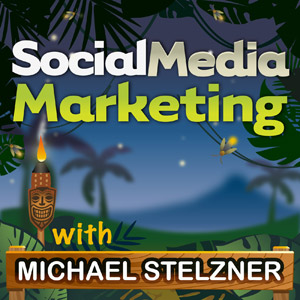
Ways to subscribe to the Social Media Marketing podcast:
- Click here to subscribe via iTunes.
- Click here to subscribe via RSS (non-iTunes feed).
- You can also subscribe via Stitcher.
What do you think? What are your thoughts on storytelling for business? Please leave your comments below.
Brain function photo, Numeric narrative photo, Story center photo and Audience connection photo from Shutterstock.
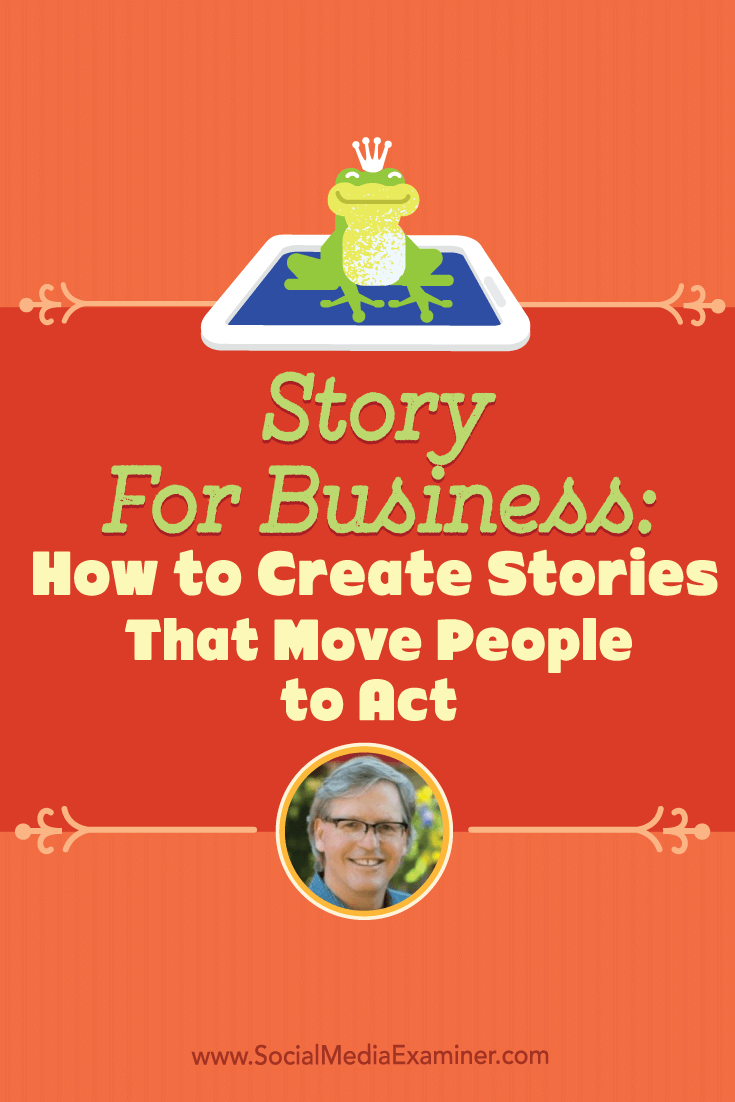
Attention Agency Owners, Brand Marketers, and Consultants

Introducing the Marketing Agency Show–our newest podcast designed to explore the struggles of agency marketers.
Join show host and agency owner, Brooke Sellas, as she interviews agency marketers and digs deep into their biggest challenges. Explore topics like navigating rough economic times, leveraging AI, service diversification, client acquisition, and much more.
Just pull up your favorite podcast app, search for Marketing Agency Show and start listening. Or click the button below for more information.

